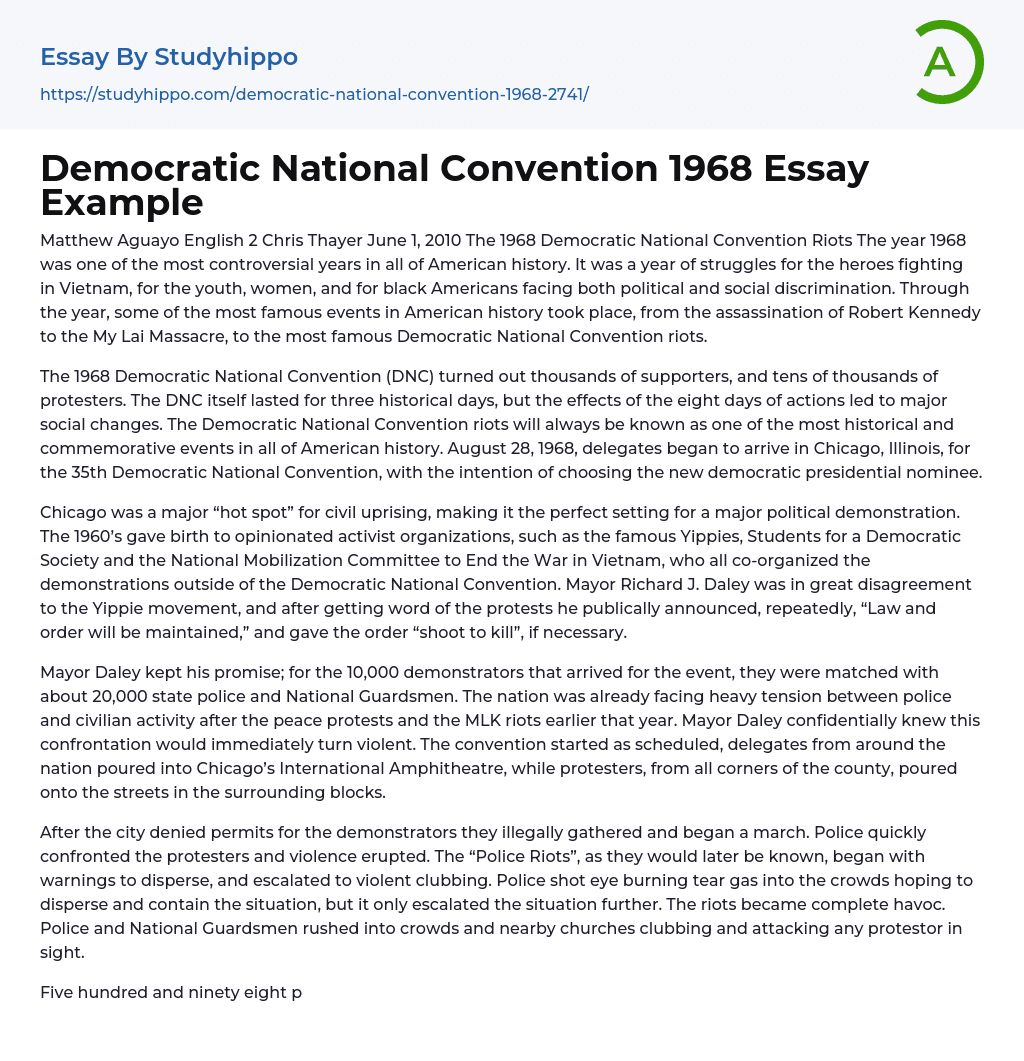The Riots during the 1968 Democratic National Convention
The year 1968 was exceptionally controversial in American history.
In 1968, America faced numerous challenges - from the heroes in Vietnam to marginalized groups like youth, women, and black Americans struggling with political and social discrimination. The year witnessed significant events such as the assassination of Robert Kennedy, the My Lai Massacre, and infamous riots during the Democratic National Convention. This convention attracted thousands of supporters and tens of thousands of protesters over three days but its actions over eight days brought about significant societal changes. The Democratic National Convention riots remain a momentous and memorable event in American history. On August 28, 1968, delegates gathered in Chicago, Illinois for the 35th Democratic National Convention with the aim of selecting their new democratic presidential nominee
....
Chicago's historical significance in civil unrest rendered it a perfect spot for a significant political protest. During the 1960s, numerous outspoken activist organizations such as the renowned Yippies, Students for a Democratic Society, and the National Mobilization Committee to End the War in Vietnam collaborated to orchestrate protests surrounding the Democratic National Convention. Mayor Richard J. Daley vehemently opposed the Yippie movement and upon discovering these demonstrations, consistently expressed his dedication to upholding law and order. He even went as far as authorizing "shoot to kill" orders if deemed essential.
Mayor Daley kept his promise to confront the 10,000 demonstrators by deploying around 20,000 state police and National Guardsmen. This action took place amidst existing tension between the police and civilians due to previous peace protests and riots following MLK's assassination earlier that year. Mayor Dale
knew that this confrontation had a high likelihood of turning violent. Despite the city denying permits to the protesters, they defiantly assembled and started marching while delegates from across the country arrived at Chicago's International Amphitheatre for the convention.
Police swiftly confronted the demonstrators, resulting in a violent clash known as the "Police Riots". The events began with warnings to disperse and quickly escalated into brutal beatings. In an effort to disperse and control the situation, tear gas was deployed by the police, causing eye irritation and worsening the situation. The riots rapidly descended into chaos as both police officers and National Guardsmen forcefully entered crowds and nearby churches, using clubs to attack any protester they encountered. On that day, 598 individuals were arrested, while numerous innocent protesters required medical treatment at local hospitals for severe injuries to their faces and limbs.
Despite there being no fatalities, the events of that day have become infamous as one of the most brutal riots in American History. It took a continuous six hours for order to be restored and for the majority of protestors to retreat to their temporary accommodations, which were primarily churches and nearby homes. The aftermath of the riots resulted in nearby parks and buildings resembling a battlefield, with bloodstained floors and numerous discarded items littering public facilities. The impact of the "Police Riots" on the city went beyond that of any potential protest or rally. Several months later, the renowned trial known as the "Chicago Seven" began.
The "Chicago Seven" were a group of radicals from various organizations who were accused of planning to incite a riot at the Democratic National Convention. However, what made their
trial remarkable was the presence of mostly middle-aged, white jurors who harbored deep prejudice against the hippie movement. Consequently, it sparked a conflict between conservative, white men and liberal, free-spirited hippies. In the end, all defendants were acquitted of conspiracy charges while five defendants received convictions for their intent to provoke a riot.
The trial gained significant publicity and support, resulting in substantial societal changes and a more progressive America. The riots at the Democratic National Convention became a turning point for the hippie movement in the 1960s. While many protesters gathered in nearby streets to demonstrate against the Vietnam War, tens of thousands of police and national guardsmen arrived with the intention of violently disrupting any peaceful rally. These events will forever be remembered as a tragic incident during an otherwise peaceful demonstration. Even today, protesters continue to fight for the same cause that was fought four decades ago through protests at police reunions. The Democratic National Convention riots will always be recognized as one of the most important and unforgettable events in American history.
Works Cited
- Johnson, Haynes. "1968 Democratic Convention". Smithsonian. 6/1/2010
- Freeman, Jo. "Confrontation at the 1968 Democratic Convention in Chicago".
- Jo Freeman 6/1/2010 . Dawson, Dawn P.. Great Events. 10 vols. New York: 2002
- Linder, Douglas O. .
"The Chicago Seven Conspiracy Trial". Famous American Trials. 6/1/2010.
6th of January, 2010.
- Malala essays
- Animal Cruelty essays
- Law Enforcement essays
- Juvenile Justice System essays
- Surveillance essays
- Forensic Science essays
- Crime Prevention essays
- Criminal Justice essays
- Criminology essays
- Drug Trafficking essays
- Juvenile Delinquency essays
- Organized Crime essays
- Penology essays
- Prison essays
- Property Crime essays
- Punishment essays
- Serial Killer essays
- Sexual Offence essays
- Victim essays
- Crime scene essays
- Punishments essays
- Charles Manson essays
- Juvenile Crime essays
- Piracy essays
- Stealing essays
- Gang essays
- Hate Crime essays
- Homicide essays
- Damages essays
- Murder essays
- Robbery essays
- Ted Bundy essays
- Prostitution essays
- Violent crime essays
- Rape essays
- Identity Theft essays
- Sexual Harassment essays
- Distracted Driving essays
- Drunk Driving essays
- Detention essays
- Sexual Assault essays
- Sexual Assault on College Campuses essays
- Cyber Crime essays
- White Collar Crime essays
- Fur essays
- Federal Bureau Of Investigation essays
- Fire Department essays
- Criminal Justice System essays
- Commitment essays
- Mass Incarceration essays




